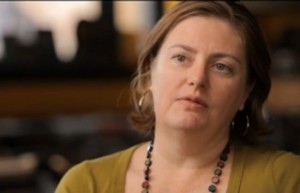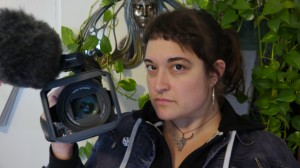

Music and musicians are often some of the biggest icons in popular culture. What we don’t often acknowledge, though, is the tireless work that other, less visible artists commit to in order to help others reach the limelight. Jini Dellaccio is one such artist, and Her Aim is True is a documentary portrait of her life and times. Dellaccio captured stunning live photos and shot album covers for countless artists including the Wailers, the Who, Neil Young, and the Sonics. Filmmaker Karen Whitehead discusses turning the lens on her in order to make this upcoming feature.
Amy Oden: What initially interested you about Jini? How did you meet her?
Karen Whitehead: A friend of a friend came across examples of Jini’s photography online and did preliminary research. When I delved deeper, I was amazed and indignant that Jini’s story had not been told, and was on the sidelines. On the surface, I had thought I was encountering a photographer who happened to responsible for a handful of cool live shots in the mid 1960s of The Who, The Rolling Stones and Mitch Ryder to name a few. Then I found out about the day she spent with Neil Young producing such stunning portraits that have rarely been seen.
As I started digging around the Pacific Northwest music scene, I realized I was in the presence of a pioneer in the rock photography field and a woman who was shooting punk before punk had a name and creating innovative album covers in her backyard. I had lots of questions but my main one was, how did this elegant woman, a shy farm girl from Indiana, wind up spending her middle age with the likes of godfathers of grunge, (The Wailers and The Sonics) who were producing such gritty, hardcore punkish sounds with songs like “Strychnine,” “Psycho,” and “The Witch.”
Jini was unconventional to say the least — she spent 12 years on the road playing jazz saxophone, years before discovering photography and had been doing stunning fashion portraiture before taking on rock ‘n’ rollers. I felt strongly after hearing her remarkable life story that by exploring Jini’s relationship with these bands, I could create something that is still relevant today, and speaks to all of us about pursuing our artistic direction, exploring the art of the possible.
An integral part of this documentary journey is crafting an intimate and fascinating exploration of how an ordinary life could become so extraordinary and hopefully, helping to preserve an important photographic legacy along the way.
Right, Jini herself was a musician in her younger years, touring on the sax in what looks like an all-female jazz troupe. Also, much is made in the film of her appreciation of musical timing as an asset when she shot live shows. Do you think it would be fair to say that her background in music is what drew her back to it as a photographer?
Jini and others interviewed in the film make the point that her musical knowledge was an invaluable aid to photographing groups. She understood timing and presentation from the inside. Taking photographs was a lyrical experience for Jini and it is all about composition, tone, and passion: all of this makes her photos so dramatic and special. From the flying guitars of The Who to the utter exhaustion of Mitch Ryder.
Do you have some kind of musical history or tie-in yourself?
I have been passionate about live music always, and especially growing up in London, really spent a lot of time enjoying the creativity of the punk scene onwards — but I am not a musician! For me, I was drawn to Jini’s experience by my love of music, photography, and women’s stories.
One of the most noticeable undercurrents in the film is how “unlikely” a band photographer Jini was. This is chalked up at various points to her age, gender, and background (fashion photography). However, at points, her “mature” presentation of the images is mentioned as an asset, and the candid, intimate shots that came out of her work are also highlighted.
I’ve had people mention the “intimate” quality of my own work as well, and it’s subsequently something I’m fairly conscious of when I interview people on camera. Also, at one point Jini mentions that, years ago, she was flattered when her work was mistaken for a man’s photography. It seems to me that music, photography, and documentary work are still all mostly-male provinces. Have you encountered this in your own career history, or during the making of this film?
There is a question here as well about pre-conceptions of how men look at the world through a lens i.e., was Jini surprising because her photography focused on first – objects of male photography — beautifully dressed women, and secondly, rebellious young men. Both at times when few women had photography careers. And Jini brought a fresh female look to this, but was so technically good. I think the assumption was — oh, she must be a man!!!
I think you don’t have to look much further than the appalling record of mainstream Hollywood regarding women’s positions in production from editing to directing to see that. However, I do think things are slowly improving thanks to the vibrant indie doc scene and increasing accessibility to technology for production — women are definitely grabbing the advances in tech such as with DSLR shooting to forge our own way. Organizations like Women In Film And Video and Women Make Movies are important support networks. I am very excited by some of the documentary projects I see emerging now.
The journey of making this film has also encouraged me to step into editing and taking on newer roles beyond my journalism roots. However, we do have quite a long way to go — the traditional film festival scene is also very male dominated because men are dominant financially — I would like to see that change!
Another theme that’s mentioned a few times is the intermingling of art with business — the tension between keeping them separate or blending them together. What’s your take on this, as it relates to Jini’s work, and also your own?
There is always a struggle and a tension between the love of art for its own sake in any field whether photography, music or painting etc, and the need to pay the grocery bills. Plus for women there is always an added one, often balancing family life, traditional expectations for women, and personal career. That tension does have a positive side in that it makes us much more driven to succeed, because we are not expected to.
Jini showed great courage and singular determination in pursuing her need to be creative in a historical period that was even more restricting in its attitudes to women than our own. If art is to be successfully developed it probably has to also show itself in a business world and Jini cleverly did this because she was always earning a living with her art and then photography, nurturing a good client base — starting with a department store model and ending with album covers and portraiture.
When can we expect the release of the film, and what’s next for you after its completion?
The rough cut is being completed with the addition of a fabulous graphics treatment for the titles and end credits, by the multi-award winning design company, Belle & Wissell, our production partners in Seattle. We are planning a few preview screenings and film festival submissions in 2013. Updates on screening plans will be posted on the film’s website.
For more information, visit http://heraimistruemovie.com/, or Check the Her Aim Is True Facebook page. Look for the film in your city soon!
Amy Oden is currently in post-production on her second feature Exotic. Information about that film can be found on her site, http://www.fromthebackoftheroom.com/, and on the From the Back of the Room Facebook.

